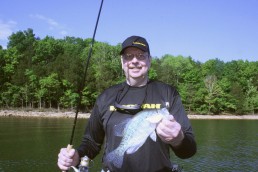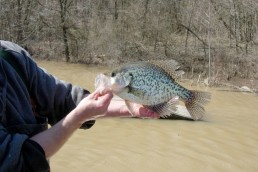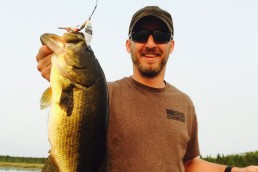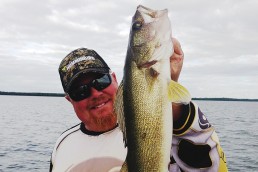Slab Prospects: Reelfoot and Kentucky Lakes
SHARE THIS POST
Picking a good crappie hole is fairly easy in April—the “ladies” are gravid and the dudes are eager to spread their joy. All they need is the “human equivalent” of a motel room. For crappies, early springtime warm water, stumps, laydowns or bushes, or patches of vegetation is all the habitat they need to make babies.
Reelfoot Lake
When it comes to catching crappies, and not just “fishing” for them, you can do no better than Reelfoot Lake.
“Reelfoot’s a better crappie fishery now than it’s ever been,” says Jeff Martin, wildlife manager. “I don’t how it takes the pressure it does in the spring, but the average fish is larger now than when I was a kid.”
Until the 1990s, Reelfoot was the only lake in the U.S. to allow commercial crappie netting.
Reelfoot’s 15,500 surface acres produce areas of dense, aquatic vegetation, and suffers from siltation.
“Siltation isn’t as bad as it was back in the 1980s,” Martin said, “and it’s still a fertile lake. I don’t how the crappie populations grow like they do when there are so many anglers.”
Reelfoot Lake is a crappie factory, says Tim Broadbent, a TWRA biologist.
“There is a lot of wood in Reelfoot for spawning crappies—stumps and logs remaining from the big earthquakes two centuries ago, plus living cypress trees and aquatic plants. The best month to catch them is during the spawn in April because it has more stable weather conditions.”
Reelfoot is about 15 miles long broken up by islands and swampy areas. Upper Blue, Lower Blue and Swan basins are probably the best fishing areas. The best places to fish for crappies in spring (with minnows, jigs or a combination) will be in water about 7 feet deep around stumps and logs where the fish bed.
Kentucky Lake
Less than 50 miles due east from Reelfoot Lake you come to Kentucky Lake that extends south to the state to Alabama—that’s a long stretch of excellent crappie-catching country.
Are you enjoying this post?
You can be among the first to get the latest info on where to go, what to use and how to use it!
One of the champion crappie-catchers on this stretch of the Tennessee River is Steve McCadams. He usually fishes within a five-mile radius of Paris Landing State Park near the confluence of the Big Sandy and Tennessee rivers. McCadams uses the old famous jigging technique called the “Kentucky Lake Double-Hook Bottom Bumping Rig (Kentucky rig for short).” Casting plastic baits on 1/8- to 1/4-ounce jigs also catches the pre-spawn crappies.
McCadams will move with the crappies as they stair-step to spawning sites. When the water reaches the low 60s, usually in early April, fish start dropping eggs. When it gets between 62 degrees and 66 degrees, Kentucky Lake has the full-fledged spawn.
“Crappies spawn shallow if the reservoir is dingy,” McCadams adds. “If the reservoir is clear, crappies spawn a little deeper.”
He says crappies are caught on the west and east banks, but the west side is usually more stained and quicker to warm. “The average depth of Big Sandy River (on the lake’s west side) is only about 8 feet deep,” he says.
Minnows fished below bobbers or on tight lines with a small sinker and a number 1 or 2 hook, is adequate for tight-lining to catch countless bedding crappies. Small plastic grubs or tubes work too. The gravel banks and points are excellent places to catch males too when water temperatures increase and the males move ahead of females to the spawning sites.
Big Sandy and the New Johnsonville areas and other creeks near the Kentucky border are beset, but there are hundreds of overlooked locations farther south too. These crappie hot spots are located on the upper end (closer to the Alabama border) where the main body of Kentucky Lake has yet to widen. Some people refer to this section as the Tennessee River and local anglers have enjoyed these spots without competition. From the mouth of the Duck River to Pickwick Dam, there are hundreds of holes, pockets, sloughs and creeks that don’t get pointed out because they are small.
The area within boating distance of Highway 412 offers the crappie angler launch sites and plenty of fishing holes. One can catch crappies all day long here and possibly never encounter another angler.
DeLorme’s Tennessee Atlas shows you where the boat launches are and the layout of the river. Some of the local favorite areas are Cedar, Marsh, Spring, Toms, Lick and Cub creeks. You’ll also want to hit the little sloughs that are formed by any runoff and the springs. They may not look like much and are the size of a convenience store parking lot, but they’ll quickly convince you they are worth the visit.
Techniques are the same as with any crappie water: use a tandem pair of 1/8-ounce jigs or the standard double-hook crappie rig. The Rosy Red minnows in a pink-to-orange hue seem to outfish the more common tuffy minnow. Start at Mousetail Landing State Park and fish up and then downstream to areas that offer both shallow- and deep-water locations. You can find some of the best action in this lightly fished region of the Tennessee River. And, the best part is you can have a hot spot all to yourself.
MWO
SHARE THIS POST
Did you enjoy this post?
You can be among the first to get the latest info on where to go, what to use and how to use it!
Vernon Summerlin
For more than 30 years, Vernon Summerlin has produced outdoor articles and books that can be found on Amazon; most recently How to Analyze a Bass Hole: Think and Catch’em! He is the recipient of more than 40 awards for magazine and newspaper articles, TV, radio, photography and books.



